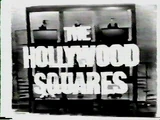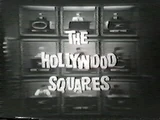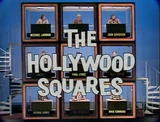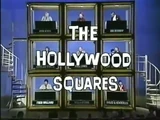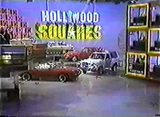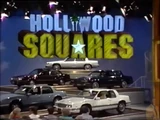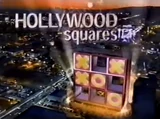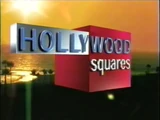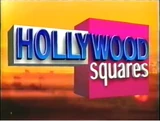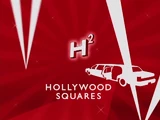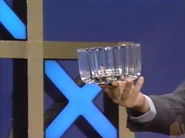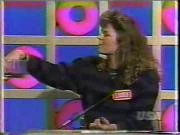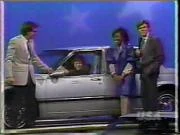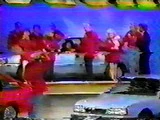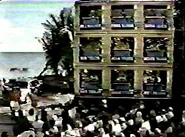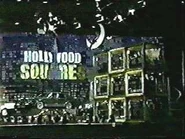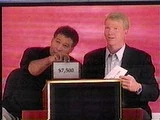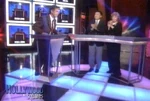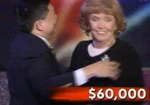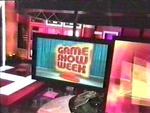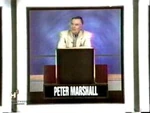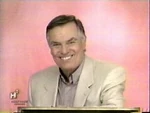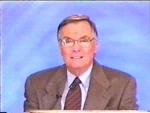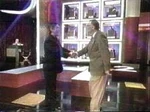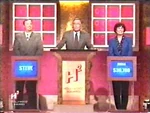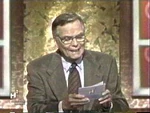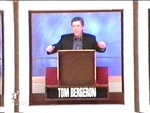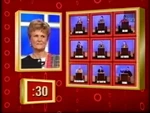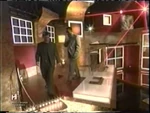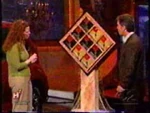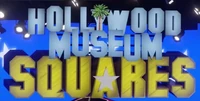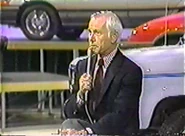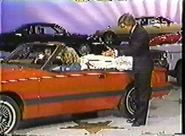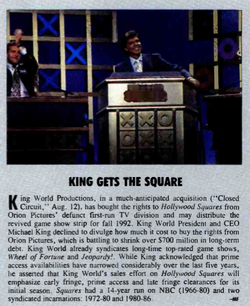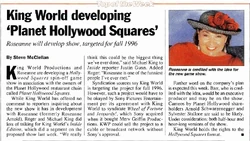| Hosts | |
| Bert Parks (1965 Pilot) Sandy Baron (1965 Pilot) Peter Marshall (1966–1981) John Davidson (1985–1989) Tom Bergeron (1998–2004) | |
| Sub-Hosts | |
| Joan Rivers Jim J. Bullock ALF Shadoe Stevens Rosie O'Donnell (1998, Secret Square Round only) Peter Marshall (2002 Game Show Week) | |
| Announcers | |
| Kenny Williams (1965–1981) Shadoe Stevens (1986–1989, 1998-2002) Jeffrey Tambor (2002–2003) John Moschitta (2003–2004) | |
| Sub-Announcers | |
| Richard Stevens (1987, 1988) Howard Stern (1988) Henry Winkler (2002, 2003) Rod Roddy (2002 Game Show Week) Shadoe Stevens (2003 Game Show Week) Mother Love (Valentine's Day 2004) | |
| Broadcast | |
| Pilot: 4/21/1965NBC Daytime: 10/17/1966 – 6/20/1980NBC Primetime: 1/12/1968 – 9/13/1968Syndication: 11/1/1971 – 4/10/1981 (reruns aired until 9/11/1981)Pilot: 12/12/1985Syndication (Daily): 9/15/1986 – 6/16/1989 (reruns aired until 9/8/1989)Syndication (Daily): 9/14/1998 – 6/4/2004 | |
| Packagers | |
| Merrill Heatter/Bob Quigley Productions (1966–1981) Century Towers Productions (1986–1989) Moffitt-Lee Productions/One Ho Productions (1998–2002) Henry Winkler-Michael Levitt Productions (2002–2004) Columbia TriStar Television/Sony Pictures Television (1998–2004) | |
| Distributors | |
| Rhodes Productions (1971–1979) Filmways Television (1979–1981) Orion Television Syndication (1986–1989) King World (1998–2004) | |
(The) Hollywood Squares (also known as H2) was the long-running game of celebrity tic-tac-toe.
Gameplay[]
Here's Peter Marshall's way of explaining Hollywood Squares:
"The object of the players is to get three stars in a row either across, up and down, or diagonally. It is up to them to figure out if a star is giving a correct answer or making one up; that's how they get the squares."
Here's how John Davidson explained the game:
"The object of the game is to simply win Tic Tac Toe, three squares across, down, or diagonally, or acquire as many squares as you can."
Here's what it meant:
The object of the game was to get tic-tac-toe. That's three Xs or Os in three stars' squares (one for each square), either across, up and down, or diagonally, or be the first contestant to capture five of the nine squares. Except for very rare occasions, the Xs were always played by the male contestant (dubbed Mr. X), while the Os were always played by the female contestant (dubbed Ms. Circle).
Here's how they did it:
The two contestants would take turns picking off each of the nine celebrities seated in a great big tic-tac-toe board. On each star, the host asked a question to that star afterwhich the star would usually give a crazy answer (classified as a zinger) followed by his/her real answer. After hearing the real answer, the contestant in control decided to either agree, meaning the star was correct, or disagree, meaning the star answered with a bluff. Sometimes a star would come up with no answer; when that happened, the host would ask the contestant to answer it himself/herself or pass it up. On a pass, the question would be thrown out, and a new question would be asked to the same celebrity.
In any case, if the contestant's judgment/answer was correct, he/she won the square (hence the phrase "X/Circle (O) gets the square" {Peter would say, "Put an X/a circle (O) there [insert answer and/or extra information]}); if the contestant's judgment/answer was wrong, his/her opponent got the square unless it would mean a win; when that happened nothing would be placed in that square because a win had to be earned by the contestant in control.
The first player to get three-in-a-row or five squares won the game and money for that game.
Secret Square[]
In certain games, one of the squares would be dubbed the "Secret Square". The contestant who picked that square would usually have sounds going off to let the contestant, the star, and everybody else know. Then the star would be asked a question that was sealed in a special envelope and was almost always multiple choice. The star gave an answer (but without a zinger) and if the contestant could correctly agree or disagree with the star's answer, he/she won a (bonus) prize (package). On two of the versions, the host would tell everybody who the Secret Square was if not chosen.
NOTE: The "Secret Square" was not featured in the original 1965 pilot.
Versions[]
Marshall Version (The Hollywood Squares [1966–1981])[]
NBC Daytime Version[]
The daytime version used the "rollover/straddling" format; this meant the show could end with a game still in progress and had to be continued/finished on the next show. Two contestants (one a returning champion, the other the challenger) played a best-of-three match with each game worth $200 (when the show started, each game was worth $100 and winning the match was worth another $300, for a total of $500 per game).
The first game of every show (unless it was an unfinished game in progress) was always a Secret Square game. The Secret Square was a progressive jackpot prize package which started at about $1,000 {for the broadcasts of 1966} with another prize added each day when it wasn't claimed {from 1967 to 1980}; by the late 1970s, new Secret Square jackpots generally started in the $3,500-$4,500 range, and often exceeded $20,000 in total value.
Starting in September 1976, the winner of the match picked a star for a prize; each star had an envelope with a prize inside, with the big prize being $5,000 in cash (the other prizes generally were valued no higher than about $2,000); whoever the winning player chose, he/she won the prize inside that envelope.
Champions stayed on the show until they were defeated or won five matches, at which point they won a bonus; from 1966 to 1976 the bonus prize was a brand new car (as well as a cash bonus plus the Secret Square jackpot if not yet won in early seasons), but in the final years of the daytime version from 1976 to 1980, the bonus was raised to a luxury prize package. This originally included a cruise, two new cars, and $5,000, totaling over $20,000; this was, however, later altered to include his/her cars, and a 52-day cruise (the latter of which was later replaced with $10,000), and finally, one new car, $10,000, and a trip for four (these later packages totaled $25,000).
There was also a slightly different tie game rule in the Marshall version than in the later versions (first player to earn five squares): A player only won a game, without getting 3-in-a-row, by earning squares sufficient to shut out their opponent from possibly getting 3-in-a-row. In most cases, this was achieved by earning five squares, but it was mathematically possible to earn as many as six squares, without getting 3-in-a-row, and still not shutting out the opponent from potentially getting 3-in-a-row (specifically, a player could get three diagonal squares even after the opponent had already earned the other six squares; this occurred at least one time in the history of the show). The player still needed, in this version of the show, to earn that shutout square themselves.
In the final episode of daytime series (which by that point had an altered contestant area and new theme music), the contestants playing that day were tied at one game apiece, but there wasn't enough time to play a tiebreaker game. So to make up for it, both contestants won an additional $200 and each selected a star and won a prize for their troubles. Then, after the final commercial break, the show's staff gathered around the contestant area for one last goodbye.
Nighttime and Syndicated Versions[]
The nighttime version was much different, for it used the self-contained format which became standard on future versions of the show. Two contestants played the game for the entire show and each completed game was worth a fixed dollar amount.
On the NBC nighttime version, each completed game awarded $300 to the winner, and the Secret Square was played in the first two games, with different prizes per game (one for a trip, and the other for a new car or boat); if the first Secret Square prize was not claimed in the first game, it carried over to the second game, and then, if it was not won in that game, it went unclaimed.
On the syndicated version, each completed game awarded $250 to the winner, and multiple Secret Square games were played on each show, each with different prize packages attached to them. During the first two seasons, the first two games were Secret Square games, generally worth about $2,500 in value; as with the NBC nighttime version, if the first Secret Square prize package was not claimed in the first game, it carried over to the second game. From Seasons 3-7 (1973–1978), the first three games were Secret Square games with package values ranging from $2,000 to more than $7,000 (at least once topping $8,000) and did not carry over to other games if they were not won. For the first months of Season 8, each of the first two games featured different Secret Square prize packages. The remainder of the eighth and ninth seasons had Secret Square games in the second and third games, again with prize values of $3,000 to more than $7,500. The Secret Square game was not played in the final season.
Should time run out in the middle of a game (signified on the syndicated version by an annoying loud horn, referred to as "The Tacky Buzzer"), the contestants were awarded $50 for every square captured in that game to their score. On the NBC nighttime version, the player with the most money won a bonus prize, whereas on the syndicated version's first seven seasons, that player won a new car as follows:
- Chevrolet Vega – Season 1 and the first half of Season 2.
- Pontiac Astre – Second half of Season 4, and all of Seasons 5-6.
- Datsun B-210 – Second half of Season 4, and all of Seasons 5-7.
- Datsun F-10 – Season 6
- Pontiac Sunbird – Season 7
For Seasons 8-9, the winner now got to choose a star and win a prize. Unlike the daytime version, where prizes worth no more than $2,000 were mixed in with the $5,000, every prize was worth at least $5,000, these included the cash, a new car (usually, either the Sunbird, Pontiac LeMans in Season 9, Datsun Li'l Hustler or a Datsun 200SX), and often a luxury vacation and other gifts (such as furs or, in one show, an "investment diamond") were offered.
If the match ended in a tie, one final question was played with the star of one contestant's choosing; if the contestant could agree or disagree correctly, he/she won the match; otherwise, the match went to the opponent. In the event a contestant should finish with nothing, that contestant still won $100.
During the later years of the run, Merrill Heatter Productions offered a substantial prize package for all contestants, win or lose.
Final Season[]
For the final season, which premiered in September 1980 as a five-day-a-week series, the show moved to the Riviera Hotel and Casino in Las Vegas, NV. In addition to the elimination of the Secret Square game, the bonus round was eliminated as well as cash per game; each game won a prize (which was awarded to both players in the case of an unfinished game), and the player who won the most games when time expired won a bonus prize (usually, an exotic trip and other gifts).
Additionally, eight of the season’s winning contestants were invited back to play in a Grand Championship tournament at the end of the season; on the final episode, Eric Lloyd Scott won the tournament and a Geodesic Dome Home from Domes America, a Botany 500 Wardrobe, a 52-day cruise on Delta Line Cruises, the first Apple II computer system, the original Sony Betamax, a Coachmen 17.5' Travel Trailer, a Midas Midavan RV, a Buick Riviera, and $20,000 in cash.
Storybook Squares[]
- Main article: Storybook Squares
During the third year of the show, a short-lived Saturday morning kid's version of Hollywood Squares was in effect. It was called Storybook Squares. In this version, the stars playing (usually the same ones from grown-up Hollywood Squares) dressed up as fairy tale characters, historic people, etc. This version lasted for four months in 1969, from January 4 to August 30, but it came back for special weeks in 1976-1977.
Like the normal version, two contestants competed (with a boy as X and a girl as O). The game was played exactly the same as the original Hollywood Squares, but no money was involved. Instead, the children played for prizes for each game won (both players earned a prize for an unfinished game). Two Secret Square games were played.
In 1976-1977, the show was brought back as a series of theme weeks. This time, teams with three generations of family members (for example, grandmother/mother/daughter) competing, and each game was worth $300, with each team earning $50 per square should time run out (similar to the short-lived NBC primetime version from 1968). The kids played for the first segment of the show, and their parents squared off in the next game and the grandparents for the rest of the game, unless time was running out (in which case all three players on each team played).
The team with the most money at the end of the game won a large prize, such as a car or exotic vacation.
Note[]
At one time, the entire set was shaken by an earthquake, and everyone left the studio (except for Paul Lynde, who stayed put in his square).
Davidson Version ((The New) Hollywood Squares [1986–1989])[]
After five years off the air, a new Hollywood Squares series was put into production. Referred to throughout its run as The New Hollywood Squares, the program debuted on September 15, 1986 and was produced by Century Towers Productions with Rick Rosner serving as executive producer and Orion Television as distributor (Century Towers was a subdivision of Orion formed to produce game shows, specifically this series and the 1987–1988 syndicated revival of High Rollers; the name was in reference to the street that Orion was headquartered at the time). This version lasted three seasons.
John Davidson, who was a semi-regular panelist on the original Hollywood Squares, hosted the series. Shadoe Stevens was the announcer for the series and, beginning late in the first season, he also became a regular panelist occupying the bottom center square. After a season of rotating center squares, former Hollywood Squares panelist Joan Rivers joined the series as the permanent center square. Jim J. Bullock was the series' third regular panelist, usually in the upper-left square. All music for the program was composed by Stormy Sacks.
In this version, just like the original version's nighttime version, two contestants played for the entire show and for each game won the winning contestant won $500; starting in Season 2, however, the third and all future games were worth $1,000. The second game of each show was a Secret Square game and it was usually played for a trip (which had Davidson coin the catchphrase "Pack your bags!" upon a Secret Square win); it did not, however, carry over to the next show if not won. Time running out was now signified by a double car horn; by that time each square claimed was worth $200 ($100 in Season 1), with that amount awarded should a player finish with nothing.
The player with the most money at the end of the match became the champion. If the match ended in a tie, one final question was played with the star of one contestant's choosing. If that player could agree or disagree correctly, he/she won the match; otherwise, the match went to the opponent (this was also done on occasions where there was no tie, but there was only enough time for one question in a game). The winner of the match went on to play for a brand new car.
The Car Game[]
For the first two seasons, this round was similar to the bonus round from the ABC version of Split Second (although Rosner originally used it on his previous game show, Just Men!). Five cars were displayed onstage under the show's logo. On a champion's first victory, he/she chose one of five keys by drawing it out of a small cereal bowl, then selected one car that he/she thought the key chosen would start. Once the car was chosen, the champion went inside the chosen car alongside a good luck celebrity of his/her choosing (all nine on Friday shows or when a champ was retiring) and on the count of three to turn the key. If the key started the car, the champion won the car and retired from the show; otherwise, he/she returned to play on the next show with the same key and one fewer car to choose from. If the champion won five days in row and didn't win the car after the first four, he/she won the car that was left.
Each week featured a different set of five cars, all of the same make. In the event that a champion on Friday returned the following Monday, the lowest-valued cars were eliminated corresponding to the number of prior attempts, and the champion selected a new key from the remaining cars available.
In the final season, each of the nine celebrities held a key, and all five cars were available each day, no matter how many times the champion had played for the car. For each victory, the champion had to first pick a car, and then a key (the celebrity who held that key would be one of the good luck celebrities). Five stars held keys for each individual car, while the other four held dud keys that didn't start any car. To compensate for this increase in difficulty, champions simply stayed on until winning a car, or until they were defeated.
The cars that were available on the show included: Ford (on the pilot), Cadillac, Isuzu, Hyundai, Toyota, Jeep, Volkswagen, Buick, Mazda, Lincoln, Mercury, Merkur, Chevrolet and Renault.
Notes[]
The show became infamous for its April Fools prank played on host Davidson, in which two "contestants" (who were actually stunt people) got into a fight after the so-called Ms. Circle "O" (Annie Ellis) caught the so-called Mr. X (Greg Barnett) cheating by peeking behind John's card. It ended by having the fake Ms. Circle push the fake Mr. X off the contestant area after which the audience said, "April Fools, John!" After the commercial break and John's explanation, the two real contestants (with one of them going for the car automatically since this was his final day on the show) came aboard and the game played as normal (as part of the prank, the contestant going for the instant car win pretended to be sick), but only two games and the tiebreaker were played that day.
During one of the weeks a record of four cars were given away in one week; during that week the Renault GTA convertible was the car that was won those four times.
The New Hollywood Squares was the first game show ever to go on the road for special weeks. It went to Hollywood, Florida, Radio City Music Hall in New York City and the Bahamas, among others.
To celebrate the 100th episode of The New Hollywood Squares, there was a very special "Announce-Off" between Shadoe Stevens and his brother Richard Stevens. Richard Stevens became the main announcer for a few months before his brother returned.
NOTE: John Davidson also mirrors to DeRay Davis who was a former semi-regular panelist on the original MTV2 version of Hip Hop Squares in 2012 before becoming the host of the VH1 version of the same name from 2017 until 2019.
Bergeron Version (Hollywood Squares/H2 [1998–2004])[]
In 1998, after a nine-year hiatus and a few false starts (see below), King World decided to bring the series back to television and a revival was put in the works. Whoopi Goldberg was brought in to be the executive producer, and John Moffitt and Pat Tourk Lee were hired as producers. Goldberg's One Ho Productions and Moffitt-Lee Productions joined Columbia TriStar Television as co-production companies with King World, who handled distribution by themselves. This differed from the other two King World/Columbia TriStar collaborations on television at the time, Jeopardy! and Wheel of Fortune, as King World had no role in the production of those two series.
On September 14, 1998, the revival debuted with Tom Bergeron as its host. In addition to her production duties, Whoopi Goldberg served as the permanent center square, with series head writer Bruce Vilanch, Gilbert Gottfried, Martin Mull, and Caroline Rhea as regular panelists and Brad Garrett, Bobcat Goldthwait, Jeffrey Tambor, George Wallace, Kathy Griffin and various others as semi-regular panelists. Shadoe Stevens returned to announce, although he was not given a square on the panel as he had been when John Davidson was host.
Payoffs[]
In the beginning (the first four weeks), the payoffs were similar to the 1980s version. Later the payoffs were doubled. Any contestant who finished the game with nothing still won the captured square amount.
| Games | First Four Weeks | Rest of the Series |
|---|---|---|
| First Two Games | $500 | $1,000 |
| Game 3 | $1,000 | $2,000 |
| Game 4 and Beyond | $2,000 | $4,000 |
| Captured Squares | $250 | $500 |
The highest front game score was $12,000 (won by a Mr. X named Tom); also the highest in the overall history of the show.
The tiebreaker was the same as the previous versions, except the player who had won more games, more squares overall or won the last game played (whichever came first) had the option to play the question or pass it to his/her opponent, with a miss by either player giving the opponent the win (and captured square amount) by default.
Secret Square[]
For at least the first few months, there were two Secret Square games; the first in Game 2, and the second in Game 3. After the first two weeks, should the Secret Square's prize not be won in the second game, it carried over into the third game. By Season 2, only one Secret Square game was played each day, but it did revive the progressive prize filled jackpot featured in the daytime version of the original. This was now called the "Secret Square Stash", the biggest of which totaled $50,731, won by Alicia Paulk on May 17, 2000 (sadly, she lost the match to John Lathan, who was the first champion to win three cars during his stay).
Bonus Rounds[]
Bonus Round #1[]
For the first three seasons, as well as early in Season 4, the show revived the Peter Marshall bonus game in which the winning contestant picked a star and won a prize inside the chosen star's envelope; these included trips, unusual game show prizes (such as a jukebox), cash prizes of $5,000, $7,500, and $10,000 (later $15,000), and the top prize of a new car. Starting in the show's sixth week, the contestant had to make a judgment on the star's answer to one final Secret Square-style question in order to win the prize. Failure to do so in the first season won a consolation prize of $2,500; this, however, was reinstated during the show's theme weeks in Seasons 2-3.
Bonus Round #2 (Big Money Round)[]
After approximately two months into the fourth season, a new bonus game was instituted in response to the recent trend of game shows offering high stakes.
In this bonus, the champion picked a star to be his/her partner. As before, each star had an envelope, only this time instead of prizes, they contained money amounts, ranging from $1,000 to $5,000, in $500 increments (if the champion picked a square that contained more than one person, the champion selected only one person from that square). The amount revealed by the selected star became the scoring amount for the round.
The contestant then had 60 seconds (one minute) (coined as "the fastest 60 seconds on television" by Bergeron) to answer as many of 10 questions (each of which contained three choices) himself/herself as possible for the value inside the envelope. The star partner could help by conferring, but only the contestant could answer. When time expired or all 10 questions had been played (whichever came first), Bergeron gave the category to a final question, and the contestant decided whether or not to answer that question in a "Double or Nothing" fashion, for a possible top prize of $100,000.
This bonus was the most complicated and controversial of all bonuses, and there were very few contestants picking the option of going for the final question; as a result, it was terminated after Season 4, with the highest payout being $60,000.
H2[]
Following the end of Season 4, Goldberg left the series & Moffitt and Lee retired. Bruce Vilanch also left his writing position and Caroline Rhea moved to New York to host The Caroline Rhea Show, a daytime variety series launched to replace The Rosie O'Donnell Show; O'Donnell had decided to leave her namesake show before the end of the 2001–02 season and Rhea, who was chosen by O'Donnell to be her replacement, served as guest host for most of the last season. The series also lost its announcer when Shadoe Stevens left as well.
Season 5 launched with Henry Winkler & his production partner Michael Levitt as the new executive producers and Jeffrey Tambor as the announcer (in addition to still being a semi-regular panelist). Winkler guest announced for several weeks during the season. Some changes were made to the overall production with the show adopting a new logo that referred to the show as "H2". The set was given a new makeover where the contestant desks we're replaced by podiums with LED screens inside and a rewritten version of the Teena Marie song "Square Biz" became the theme song.
After Goldberg's departure, at first the show did not feature a traditional permanent center square. Instead, a new celebrity was in the center square each week. Ellen DeGeneres, Alec Baldwin, and Simon Cowell were among those who played center square, and also Peter Marshall, who appeared during a Game Show Week (he also hosted the main game portion on the Thursday of that week) in 2002. For the final season, Martin Mull became the permanent center square.
Starting with Season 5, all Secret Square questions were visual questions.
In the 6th & final season, the show revived the best-two-of-three match format from the NBC Daytime version, with each game being worth $1,000 ($2,000 wins the whole match); this resulted in the show no longer being self-contained, as matches could (and often did) straddle episodes. If a player didn't win any money during this season, he/she received acknowledged parting gifts. The scoring format from the first five seasons was used during theme weeks where certain groups of people (lifeguards, celebrity lookalikes) played. In addition, the "Secret Square Stash" was discontinued, allowing different prizes to be played for in each match, regardless of whether the previous match's prize was won or not (similar to the Davidson version). Also, the world's fastest talker John Moschitta became the new announcer while Shadoe Stevens returns as sub announcer during the second Game Show Week.
The Master Returns[]
On December 12, 2002, during Game Show Week, both Marshall and Bergeron traded places with each other. This was the only time Marshall would host an episode of Hollywood Squares since his version went off the air in 1981. In the episode, Marshall hosted the first portion of the show, with Bergeron taking over for the bonus round much later in the episode.
The Return of the Key Game[]
H2 also re-instituted the key bonus round from the John Davidson version, but with a new twist. The bonus was split in two parts; in the first part, the champion had 30 seconds to capture as many stars as possible. On each star, host Bergeron read a true/false statement about the celebrity chosen, and all the contestant had to do was to agree (true) or disagree (false) on that statement.
For each star captured, an incorrect key from a grid of nine was eliminated. When time ran out or if he/she went through all the stars, Tom and the contestant went over to the keys alongside the grand prize he/she was playing for. The number of bad keys according to the number of squares captured were blacked out (with one free key blacked out for each repeated attempt at the same prize during season 5), and the contestant had to choose from the ones still lit. For themed weeks, one key was eliminated at the outset in addition to any keys eliminated for each star captured. During season 6 (minus theme weeks), the champion always had nine keys to work with regardless of how many times he/she is playing for the same grand prize.
Once the contestant chose a key & if it worked, he/she won the grand prize; if not, he/she will receive a consolation prize ($1,000 in season five, then reduced to $500 in season six) for each square captured. The contestant could also win the grand prize if he/she captured all nine stars (which happened on four episodes) or eight stars to leave only the winning key left.
Prize Structures[]
Here are the grand prizes for Season 5:
- Car
- $25,000 cash (in a safe)
- Trip around the world (worth $30,000) (in a steamer trunk)
- $50,000 cash (in a safe)
- Unknown, but rumored to be $100,000 cash (in a safe)
Nobody ever made it to the final prize, though the highest a player tried to win was $50,000 cash. During special weeks, the bonus was played for either $25,000 cash for charity, or a car during special non-celebrity weeks.
Here are the grand prizes for Season 6:
- Vacation (worth $10,000) (in a steamer trunk)
- $10,000 cash (in a safe)
- Luxury car (worth $40,000)
- $25,000 cash (in a safe)
- Trip around the world (in a steamer trunk)
Only one person (Ted Wells) made it to the final prize, but that contestant managed to win the first four prizes. During special weeks, the bonus was played for $10,000 cash or a car.
Returning Champions[]
In the first season, there were no returning champions; at that time two new players competed every day. Starting in Season 2, champions stayed on the show until they won five matches or were defeated, and in matches with returning champions, the challenger always began the first game.
Tournaments[]
Tournament of Champions[]
Starting in Season 2, the show began having an annual Tournament of Champions each May, with the season's biggest winners returning to compete for additional cash and prizes. The format changed each season:
- Season 2 – Six five-game winners came back to play again. Play was as normal, except the Secret Square was worth $2,500, which was added to the score. The bonus game was also played for cash, ranging from $5,000 to $15,000 (in $1,000 increments). The two contestants who earned the most money came back for a two-game final, playing by the same rules as the semi-finals. In addition to the other cash won (including either $10,000 or $15,000 in the final bonus round), the champion won an extra $50,000.
- Seasons 3-4 – Eight five-game winners competed in a semi-final game. The two top winners returned on Friday. The Secret Square prize was an actual prize, again added to the final score, but was the same each day so that no one would have an advantage. The grand champion won $25,000, and a Jaguar was among the prizes in the bonus game. Season 4's tournament was similar to that of the previous year, except the bonus game winnings were taken into account. The final grand champion automatically won a Mercedes-Benz in addition to the money.
- Season 5 – Season 5 had a "Close but No Cigar" week to decide who would join the seven undefeated winners in the normal tournament. The bonus round was played for a $25,000 Bloomingdale's shopping spree until Friday, when it was replaced by a cruise on the RMS Queen Elizabeth 2. The winner of the tournament then chose one of the celebrities who then revealed a cash amount of up to $50,000 inside a sealed envelope.
- Season 6 – The winner of the tournament played the standard bonus round, and chose one of the captured celebrities afterward: each celebrity had an envelope with a grand cash prize in it (either $30,000, $50,000, or $100,000).
College Championship[]
Each year from Seasons 2 through 5 had 14 college students competing. Seven quarter-final games were played. The four contestants with the highest overall totals advanced to the semi-finals. The two winners played in the final game, where the winner won a $25,000 savings bond (later a car), as well as a trophy for their university. Secret Square and bonus round prizes were added to the totals to determine who moved on.
In Season 5, the bonus round was played for $25,000 (savings bonds in the quarter-finals & then cash in the semi-finals), and the grand champion automatically won a new Jeep Wrangler.
In 2001, Goldberg was not present during some tournament shows, having Caroline Rhea and other celebrity guests taking over center square. In the Finals, comedian Jiminy Glick (played by Martin Short) took over center square.
Notes[]
On October 1, 1999, a well-known happening occurred in which Gilbert Gottfried said "YOU FOOL!" after the contestants missed six consecutive tries on their decision whether they agreed or disagreed. The seventh time, Gottfried and the contestant agreed, finally winning the square and the game.
Hollywood Museum Squares[]
In 2021, The Hollywood Museum announced a limited run revival of the series as a fundraiser for the organization. Dubbed Hollywood Museum Squares, each episode is introduced by Marshall and announced by Harvey, with Davidson, Bergeron, Vilanch, Pat Finn and Marc Summers rotating each hosting one of the episodes. The panelists for the game included Loni Anderson, Alison Arngrim, Rico E. Anderson, Gilbert Gottfried, Rich Little, Jerry Mathers, Donna Mills, Judy Tenuta and Lindsay Wagner, among others.
VH1's Celebrity Squares[]
Coming Soon!
Pilots and Proposals[]
1965 Parks Version[]
On April 15, 1965, a pilot for The Hollywood Squares was shot with Bert Parks as the host instead of Peter Marshall, along with many of its first regulars: Charley Weaver, Rose Marie, Wally Cox, Abby Dalton, and Morey Amsterdam along with Gisele Mackenzie, Jim Backus, Vera Miles and Robert Q. Lewis making up the nine boxes. The gameplay was very similar to the actual series as well. The contestants played the best two out of three match, and each completed game was worth $250 with the winner returning in the next match. A few differences between the pilot and the actual series were these:
- The Contestant Area was reversed with Miss Circle (O) on the left podium and Mister X on the right podium.
- Instead of asking the contestants "Do you agree or disagree?", the host would ask the contestant, "I ask you, Mister X/Miss Circle (O), is that question right or wrong?" If the contestant got it right, the host would say, "And he/she gets it right. X/Circle (O) gets the square!" If the contestant got it wrong, the host would say, "I'm sorry, that's wrong. X/Circle (O) gets the square!"
- Jim Backus (Mr. Thurston Howell III of Gilligan's Island fame) was the center square in the pilot. However, the late Ernest Borgnine (of McHale's Navy fame) was the first center square when the show premiered on October 17, 1966.
- There was no "Secret Square" round at all in the pilot.
- When a contestant correctly guessed the celebrities' answer right or wrong, a very short and out-of-place victory cue would be played.
- After a contestant (either Mr. X or Ms. Circle) won his or her two games, a new challenger comes into play.
- Sometimes one star would answer the question, then another star would blurt out a "Zinger". Even Bert Parks himself would even set them up to do so for example:
- Bert Parks: "This question is about age…who is older, Dean Martin or Joey Bishop?"
- Charley Weaver: "I know Dean Martin drinks whiskey that is older than Joey Bishop!"
- (After contestants’ misses) Morey Amsterdam: "Bert, you know, The Twentieth Century was going to do a story on Dean Martin but they couldn't get a liquor license."
In conclusion, the show was disjointed. There's a good reason for it. According to The E! True Hollywood Story documentary from 2003, it was revealed that the taping session was riddled with technical and other problems. Audience members started to walk out, and the producers even handed out $10 bills to tourists at the Farmer's Mart to fill in the seats. Tapings finally wrapped up at two in the morning. CBS’ head of daytime Fred Silverman in 1976 told former webmaster Steve Beverly, "Bert Parks was a terrible host, If they'd offered us Peter Marshall, then I might have changed my mind!" Both NBC and CBS have shot down the pilot twice but for NBC's case, they apparently saw enough there to work with to green-light it after a second look, but this time with "The Master" Peter Marshall himself as host instead of Parks. (NOTE: Marshall says in his book Backstage With The Original Hollywood Square that there was a second pilot shot, this time with comedian Sandy Baron as the host, even though Marshall himself claims that he thinks he spotted it on tape in 2005. As of now, there's no confirmation if the Baron Squares pilot exists or not. Also, Sandy Baron would later serve as a panelist on the actual show itself).
1985 Davidson Version[]
After Match Game-Hollywood Squares Hour died an ignominious death in daytime on NBC in 1984, Orion Television wanted to keep the franchise alive. They did so by taping an all-new pilot for the revival on December 12, 1985. Sadly, Peter Marshall wasn't invited along for the ride, so former "semi-regular" square John Davidson (who would incidentally go on to do the 1986-1989 show itself) became the host instead. along with: Burt Reynolds, Loni Anderson, Jackie Collins, Marla Gibbs, Apollonia Kotero, Dick Butkus, Bubba Smith, Steve Landesberg, Tony Danza, and Dom DeLuise joining in on the classic "Star-Studded" game of tic-tac-toe fun.
Each game was worth $500, with game #2 always being the "Secret Square" game. On this particular pilot, one of the most interesting questions occurred when then-late night King Johnny Carson did a walk-on cameo appearance (which you can see below) for a question. After stealing the show (and about three minutes of air time) the game continued. Whoever had the most money at the end of the game went on to play the bonus game.
The Bonus Game[]
The bonus game for this pilot was to simply pick a car: a celebrity was along for good luck and if the car was the "pre-selected" car (a 1-in-5 chance), the contestant won the car he/she picked.
Possible 1992 Revival[]
At the time, when King World[1]bought the format rights from Orion Pictures, they once considered reviving the show in syndication for the Fall 1992 season, however, the idea was scrapped later on.
Planet Hollywood Squares[]
In 1995, King World teamed up with comedienne Roseanne Barr along with a popular restaurant chain Planet Hollywood tried to do a spinoff of the show under the name Planet Hollywood Squares[2]where it was intended to be paired up with a revival of The Gong Show, but was held off until 1997 just to see if their revivals of The Dating Game and The Newlywed Game were working out. Sadly, this never came into fruition.
Potential revival (2014)[]
According to an 2014 article from TVNewsCheck[3]it was reported that "If opportunities arise, syndicators could dust off some game show projects. They include CBS Television Distribution's Hollywood Squares." However, this never came in development stages.
West Virginia One-Off[]
From June 23-24, 2014 a part of an event called FestivALL; a one-time special entitled The West Virginia Squares[4][5]aired on local television station WVPB (West Virginia Public Broadcasting) official YouTube page and on wvpublic.org in West Virginia, with Peter Marshall (a West Virginia native) reprising his role as host while trivia questions were mainly based on the music and history of its state aired for only four episodes. The "celebrities" that were seen in this special were: Larry Groce, Landau Eugene Murphy Jr., Bil Lepp, Donnie Davidson, Charlie McCoy, Autumn Blair, Joyce DeWitt (a.k.a. Janet Wood of Three's Company fame who was a panelist on the original Hollywood Squares and was also a local West Virginia native like Marshall), Charisse Hailsop, Danny Jones, Steve Bishop, Billy Edd Wheeler and Michael Cerveris.
VH1's Celebrity Squares[]
On July 23, 2023; BET recently announced a new version of Squares called Celebrity Squares. Set to start taping this August and will air on VH1 starting in October.[6][7]
Rating[]
Music[]
1965-1969 – "The Silly Song" by Jimmie Haskell and his Orchestra
1969-1979 – "Bob and Merrill's Theme"/"Merrill and Bob's Theme" by The William G. Loose Orchestra
1979-1981 – Stan Worth and his Orchestra
Open – "The Hollywood Bowl #2"
Close – "The Hollywood Bowl #1"
Prize Cue – "The Hollywood Bowl #3"
Unused – "No. Hollywood"
1986-1989 – Stormy Sacks as "It's Hip to Be The Hollywood Squares (remixed in 1988-1989)" (NOTE: The title of this song is a reference to the Huey Lewis and the News song Hip to Be Square from 1986)
1998-2002 – "I Love Hollywood" by Jennifer May Mauldaur and Paul David Weinberg (remix in 2001-2002)
2002-2004 – Teena Marie
Main – "Hollywood Square Biz"
Original – "Square Biz"
Theme Lyrics (1998–2002, "I Love Hollywood")[]
Sung By Whoopi Goldberg (1998-2001) and Bruce Willis (2001-2002 as the remixed theme)
I'm driving down Hollywood Boulevard
With the wind in my face
Life is good!
Chorus:
I LOOOOOOOVE HOLLYWOOD!
The lights and the cameras, the glitter, the glamour!
I LOOOOOOOVE HOLLYWOOD! (Yeah)
The lights and the cameras, the glitter, the glamour!
I LOOOOOOOVE HOLLYWOOD!
The sun's always shining, and life is good!
(Chorus repeats)
Theme Lyrics (2002–2004, "Hollywood Square Biz")[]
Sung by Teena Marie
(Whoo!) Everybody get up!
It's the Hollywood Squares!
(instrumental)
Flashback, who's that
Have you heard the latest
Playing with the greatest on the Hollywood Squares
That's what I said, if you didn't know yet
This thing it was kismet, you can feel it in the air
CHORUS:
So did you have a doubt, I'm 'bout to spell it out
We're playing Hollywood Square biz
We've got the best, the most, players from coast to coast
And I don't wanna boast, it's Hollywood Square biz
BRIDGE:
I'm talking square biz to you people
(Square, square biz)
Hollywood Squares, that is
(Square, square biz)
I'm talking 'bout circles and Xs
(Square, square biz, Hollywood Squares)
Hollywood Squares that is, square biz
(instrumental)
Put a circle in that square
Square biz
Put an X in that square
Square biz
CHORUS THEN BRIDGE
Square biz
Square biz, square biz
(Hollywood Squares)
Square biz, square biz
Square biz, square biz
(Hollywood Squares)
CHORUS
(Instrumental break 1)
Hollywood square biz
We're playing square biz
Hollywood square biz
(We're playing Hollywood square biz)
We're playing square biz
(Instrumental break 2)
Square biz
Square biz
I'm talking Hollywood square biz
Your number's up, no
Dismiss, dismiss
Flashback (x4)
CODA (CHORUS)
NOTE: For the original version (Square Biz) from which this theme is based, click here.
Studios[]
- NBC Studios, Burbank, CA (1966–1980, 1986–1987)
- The Versailles Theater at Rivera Hotel, Las Vegas, NV (1980–1981)
- The Prospect Studios (ABC Television Center [West]), Los Angeles, CA (1987)
- Fox Television Center (Metromedia Square), Los Angeles, CA (1987–1988)
- Universal Studios, Hollywood, CA (1988–1989)
- CBS Television City, Hollywood, CA (1965 pilot, 1998–2004)
- Hollywood Museum, Hollywood, CA (2021)
Spin-Offs[]
Storybook Squares – a short-lived kids' version that aired on NBC in 1969 and 1976-1977.
The Match Game-Hollywood Squares Hour – an hour-long, short-lived combination show that also aired on NBC from 1983-1984.
Paul Lynde: Off Center - an episode of the documentary series Biography where it profiles the life of the actor & comedian that aired on A&E in 2001.
E! True Hollywood Story: Hollywood Squares - an episode that covers the show on E! in 2005.
The West Virginia Squares - a one-time only special for the state of West Virginia airing on WVPB/West Virginia Public Broadcasting's official YouTube channel (and wvpublc.org) hosted by Peter Marshall for only four episodes in 2014.
(MTV2/VH1) Hip Hop Squares – a short-lived rap/hip-hop version that aired on MTV2 in 2012, then was later rebooted on VH1 for three more seasons from 2017-2019.
(CMT) Nashville Squares - CMT's short-lived, country music star-centric version that started (and ended) in 2019.
Hollywood Squares (channel) - A channel on Pluto TV's that devoted to air nothing but the Bergeron version 24/7 since 2023.
(VH1) Celebrity Squares - the Black/African American centric remake that also airs on VH1 (originally BET) in 2023.
International Versions[]
Here are a list of places that did their versions of Hollywood Squares:
- Arab World
- Argentina
- Australia
- Belgium
- Brazil
- Canada (French language only)
- China
- Czech Republic
- Denmark
- France
- Germany
- Greece
- Hungary
- India (Telugu language only)
- Indonesia
- Israel
- Italy
- Japan
- Malaysia
- Netherlands
- Peru
- Poland
- Russia
- Singapore
- Spain
- Sweden
- Thailand
- Turkey
- United Kingdom
- Vietnam
Merchandise[]
Main Article: Hollywood Squares/Merchandise
Additional Pages[]
Hollywood Squares/Celebrity Guests
Hollywood Squares/Quotes & Catchphrases
Hollywood Squares/Episode Guide
Hollywood Squares/The Squares In Popular Culture
Hollywood Squares/Video Gallery
Hollywood Squares/Merchandise
Galleries[]
To see pictures of the many logos over the years click here.
To see press photos, pictures and drawings of Hollywood Squares, click here.
References[]
- ↑ Look under the blurb King Gets the Square
- ↑ Roseanne, Planet Hollywood Reviving Game Show
- ↑ Syndicators Serious About Playing Games
- ↑ Peter Marshall to Host 'West Virginia Squares'
- ↑ Game Show Features West Virginia Music and History
- ↑ Hollywood Squares Revival Greenlit by BET - Buzzerblog
- ↑ Celebrity Squares - OS | LA Productions - An Audience & Seat Filler Company
Links[]
A tribute to the original The Hollywood Squares
Woogazoid's 'Hollywood Squares' page
Curt Alliaume's history of the Hollywood Squares
Hollywood Squares @ Tim's TV Showcase
Screencaps of The 80s Hollywood Squares
Xanfan's Hollywood Squares Celebrity Archive
Official Website
Information on the 1998-2004 incarnation
David's Hollywood Squares Page
Rules for Hollywood Squares @ Loogslair.net
"Hollywood Square Biz" by Teena Marie ('02-'04 theme song)
Article about the original 1965 pilot
Article about the 1985 pilot
